An Investigative Analysis into the Stagnation of the Shot Put Glide
- CJ Licata
- Jan 9
- 20 min read
Updated: Apr 7

The glide shot put has seen a stall in growth for many years. Coaches will tell you that both the rotation and the glide can produce high-level results, but it depends on the specific athlete. However, I attest that there are maybe five coaches in the country who have a high-level understanding of glide shot putting. I believe that many coaches would rather not have anyone glide, even if the athlete would throw farther. They do not know what to do with gliders. I will be the first person to confirm that the vast majority of athletes should spin. The rotation has given people of all statures and body types the ability to compete at a high level. However, the notion that everyone should spin is a point with which I wholeheartedly disagree. The reasoning is very stereotypical and inherently misleading.
Since my high school days, I was told that to glide “you have to be so strong” or “have a massive stand throw.” I wondered, where do these ideas come from? Most originate from the old school days of the 70s and 80s, when drug-fueled gliding saw 20- and 21-meter stand throws as common. To spin means to not need these large stand throws or huge strength numbers… or does it? The idea that the rotation magically grants 12-15 foot conversions from stand to full is misleading. In addition, many athletes today are stronger than the steroid users of the past. Joe Kovacs squats 1,000 lbs. and Darlan Romani benches 700 lbs., with the former exceeding 20m from a stand. When I was being recruited, I thought, why would I want to switch? I benched 245 lbs., squatted 315 lbs., and cleaned 225 lbs. I had a 53-foot reverse stand and glided 61-8 as a junior. Was the rotation going to magically give me a meter or two? There are no guarantees in throwing far. I knew that as weak as I was there was so much growth to be made. I also had to consider that I had a 20-foot improvement from the year prior and was very new to gliding. I also loved gliding; it felt so natural. David Storl threw 21.78m and won Worlds in 2011 with a 365-pound bench press. Storl had stand throws over 20.50 in his career; is this a downside to gliding? John Brenner is said to have stand throws around 19 meters but had a large 3+ meter conversion. I was taught that good gliding should achieve 3 meters on top of your best and hardest stand throw. Most athletes, for both rotation and glide, are achieving 6-10 feet on their stand-to-full conversions. Find a technique that allows you to do so. The day I threw 20.51, my stand was 17.20. However, this was with a non-reverse; a reverse stand throw would go farther and decrease my conversion, which would lead to the assumption that the glide is not maximizing distance. It is very subjective. Not all stands are created equal.
The glide and the rotation are not all that different. Many think that to be a great glider, you have to do endless stand throws or just train with heavy shots. Stand throws are a means to an end, not the end goal. In an interview with Mike Stulce, he stated he stopped doing stand throws when he “became world class,” as he felt it “compromised [his] glide.1” However, stand throw and glide training tend to complement each other as you find specific feelings in both. I was not just gifted at throwing stand throws relatively far; I worked at them and tried different styles that gave me transferable feelings to the glide and also helped with distance. Additionally, during my time at Princeton, I never threw a ball heavier than a 17 lb shot.
1 Pingleton, “Interview with Mike Stulce”, Nasgaweb Forums, North American Scottish Games Athletics, 8 January 2011, http://www.nasgaweb.com/forum/interview-with-mike-stulce_topic11586.html
But, gliders need heavy shots because they have to be so strong! Luckily for me, Coach Fred Samara at Princeton told me in my first month of training that we needed to transition to a drop-in entry as opposed to a crouch start. Light balls helped us find the speed, separation, and firing of the throw like a cannon. We modeled Alessandro Andrei’s entry. I stood threw 14.50 my freshman year and threw 18.27 with a 330 bench, 445 squat, and a 300 clean. I also know that David Storl’s training as a junior and even his early career as a pro was filled with light shots. His coach, Sven Lang, explained that this approach taught him to create great push-off speed from his heel and also led to high release velocities.2
Another factor is the biomechanical one; rotational throwers often stand very upright to mimic their delivery position. Gliders bend very low on their legs in the stand throw and hit the ball in a very linear fashion, which inherently produces a farther throw. Any drill or throw not practiced will also lead to larger conversions. The more one practices something, the better they will become at it. Crouser had thrown 70 feet from a stand and had yet to break 23m; but why? Shouldn't he add 3-5 meters as a spinner? It’s all relative. I trained with Josh Awotunde for three years and never saw him throw over about 17m from a stand. His PB is 22.29! However, Josh never trained the stand throw with lots of intensity or did them for distance. They were non-reverse with little to no transfer. If he had, I would bet my life that they would be over 60 feet, which is still a great conversion. His half-turn was close to 20m, though, and is more of his indicator. Storl practically flings over the toe board when he throws. You can game stand throws for distance, but the biggest factor is choosing a style that improves and feels like a full throw.
Runnersphere did an article on Ryan Crouser in 2017 and wrote, “Crouser said today's top throwers generally fall into two camps – the 'speed model' exemplified by New Zealand's [Tom] Walsh, and his own 'long lever,' more deliberate rotation.3” Crouser’s discussion is very interesting and can be applied to the glide model. Many speak of the glide as if it is one ubiquitous style. However, there are many different styles and models. If the “long-levered” idea is applied to gliding, then throwers like Tomasz Majewski, Udo Beyer, Borja Vivas, Ralf Bartels, and Ladislav Prasil would be at the top of the list. These men all had large stand throws with very static entries, where Majewski’s best was around 20.50 in a competition warmup4 and Beyer’s was rumored to be 22m. Their techniques, from my interpretation, appear to fall under the idea of a glide being ‘momentum into a stand throw.’ Prasil and Bartels even non-reversed and rarely transferred in their finish, where the latter was only 6-1.5. However, the “speed model” would include throwers like John Brenner, Michael Carter, Al Feuerbach, Alessandro Andrei, Ulf Timmermann, David Storl, Manuel Martinez, and others. Many of these still had large stand throws. Others, like Gunthor, Mike Stulce, and Franck Elemba, would be more of the “hybrid” between the two. Another point Crouser makes is how these two styles are more refined technical models, where, through the 1990s and 2000s, you saw many people throwing with various rotational techniques. Now it has transitioned to two models.5 However, glide shot put has not seen much innovation, and many view the past greats as perfect technicians and the epitome of the sport. How can someone throw farther than Ulf Timmermann or Udo Beyer without drugs? Perhaps the thought is that these men did not try to maximize their glides as much as they relied on a dominant stand throw to create consistency. One of the reasons their stand throws were so large is the style and emphasis with which they executed them. It is important to note that the East German model of stand throw emphasis was for specific reasons. In an old reposted Ring forum article, Timmermann explains, “We used to train this way in DDR in long time back. But problem occurred. To have poor stand [meant] one must glide many times. Many times glide broke the athlete. Sad good bye to many hurt athlete.6” Additionally, the style of their stands, according to another Ring post by Viking (who was thought to be Timmermann), said, “A standing throw has much more potential for giving the thrower the chance to hit perfect positions. I am NOT talking about replicating the position the thrower comes in the final power position from a stand. This way Timmermann would have 3m differential too. I'm talking about going from a stand and driving the shot much more down and to the thrower's right than any thrower in the world would be able to do in a full throw. Giving the shot a longer path, almost the same as with the full throw but with almost 100% of it accelerating and without unsupported phases. This gives the right leg the chance to use its strength only for lifting and turning and not losing any power from absorbing impact forces. THIS is what the Germans were measuring as standing throws.7” Crouser’s point is that the rotation has seen an evolution and a different understanding; maybe it is time for the glide to have the same. We have athletes pushing the strength levels of the drug-fueled era of the 70s and 80s who can generate lots of speed and power.
2 Schmidt Media, “Vision Gold - Kugelstoßen,” YouTube Video, 23:15, 22 February 2012. https://www.youtube.com/watch?v=Z_X6u2EN5iM
3 Binder, Doug. “In Video Age, Crouser Can Study, Adapt, Improve His Technique,” Dyestat, 26 September 2019. https://www.runnerspace.com/gprofile.php?mgroup_id=44531&do=news&news_id=585889
4 Martin Maric, “17. Tomasz Majewski - 2x Olympic Champion,” YouTube Video, 44:06, 25 January 2021, https://www.youtube.com/watch?v=pVIkSGAhVh0
Imagine if you took an Alessandro Andrei drop glide entry and applied it to the out-and-over setup of Gunthor, with the low attack of Ulf Timmermann, while having as quick of a right foot as Al Feuerbach, coupled with the blocking and length of Tomasz Majewski. This would produce a special throw. Instead of thinking of the past greats as individual models of perfection, why not consider how these models together could produce a special effect for the right athlete? Again, this article is not to profess the need for glide popularity. However, it points out many misleading points and reasons for the stagnation of the glide. The amount of literature on the rotation is astounding. The resources on the glide are few and far between. This could be due to the lack of American success in gliding since the early 1990s. There would be less need to provide education. People act as if the rotation is a new concept in the U.S., yet the U.S.A.'s last 20.50+ glider other than myself was Tonyo Sylvester at the 2002 USA Outdoor Championships. Sylvester was 34 years old, 6'1", and a member of the United States Military.
5 Binder, Doug. “In Video Age.”
6 Pingleton. “Ulf Timmermann’s posts from the Ring,” Nasgaweb Forums, North American Scottish Games Athletics, 1 March 2010. http://www.nasgaweb.com/forum/ulf-timmermanns-posts-from-the-ring_topic10241.html
7 Pingleton. “Glide 2,” Nasgaweb Forums, North American Scottish Games Athletics, 15 February 2008. http://www.nasgaweb.com/forum/udo-beyer-stats_topic6438.html
The understanding of the glide needs to be broken down so people can comprehend how the Europeans and old-school Americans had success with certain athletes. Even athletes with very poor technique managed to throw reasonably well and compete against their rotational counterparts. My point is that some athletes are more suited for the glide, but if coaching is going to be as novice as “unseat and catch the ball back and lift in the finish,” then we should not even bother. The words "unseat" and "lift" have been banned from my vocabulary and have caused more harm than good for me. Coaches need to understand the long-term vision of a new glide model and how an athlete can throw far. What makes the glide successful for some is the idea that you can be a ‘horse out of the gates’ in the entry and reach top speed quickly. To slightly wrap the upper body can create extra stretch to an extremely dynamic power position that becomes a full-scale catapult into a violent reverse linearly. The rotation has a very slow-to-fast acceleration, while the glide requires a specific quick and explosive athlete. This does not have to be a weight room metric, but rather a natural athleticism one. I remember seeing videos of a few glide shot putters who non-reversed not insignificant distances with very little attack or a right foot that merely pushed and never turned. Then, when they became stagnant with the glide, they converted to the rotation with aggressiveness and a dynamic reverse. When they threw farther, they expressed how much the rotation was better than the glide. If we are going to approach the spin like a science, why are we approaching the glide with no sense of intuitiveness? The truth is that many will do better with the spin, but you get out what you put in and shouldn’t blame the glide for your own lack of understanding.
My own comprehension of the glide and how I’ve arrived at this notion is based on great foundational teachings from coaches Tony Naclerio, Fred Samara, and Mike Sergent, paired with years of intense self-study. In 2018, during my senior year indoor season of high school, I threw 64-5.5’ at a meet in the Armory. I posted it on my Instagram and received a direct message from Cedric Trinemeier, a German shot putter, who inquired if it was 7.26 kg. I told him it was with the 12 lb shot, and we messaged back and forth about glide shot put. At the time, he was a 19.02 glider who was about 6'6" and two years older than me. He told me he was relatively weak and had a stand throw PB of about 17.80. This amazed me. I knew that many gliders had big stand throws, but a 17.80 stand and a 19.02 glide seemed strange to me. I was taught to get 10 feet from a good glide conversion. His style seemed to be a bit static, and he did not turn his right foot or maintain ground contact as I had always been taught by Naclerio. Trinemeier told me that he believed the way he was using his right foot allowed him to get more out of it. He ended up throwing 19.37 that year as his lifetime best; eventually, he tried spinning and could not beat the PB. Naclerio emphasized the Feuerbach method of turning the hips and keeping the ball way over the right leg as you turned. I started to look at other gliders in Germany and Europe and noticed many did not do this. I understood the difference between the short-long and long-short methodologies of glide shot putting, but there were many things I scratched my head at and saw as inefficiencies. I watched videos of Dennis Lewke and Tobias Dahm, two German gliders with PBs of 20.03 and 20.56, respectively. Krzysztof Brzozowski was a Polish glider with a 6 kg PB of 23.23 and a mere 19.63 PB with the 16 that I also watched. These three, along with Trinemeier, all threw with the European style of a large base and a right knee that turned, but not the right foot. In a presentation by Adam Nelson and Michelle Carter on YouTube (which I cannot find now), they discussed how American throwing typically emphasizes the right foot turning in the middle of the throw as opposed to the European style of knee rotation. In theory, these should accomplish the same thing. However, in videos of Trinemeier, Lewke, Dahm, and Brzozowski, they all had right sides in the middle that saw barely any turn from their knee or foot, instead just pushing from their right leg, which stopped the hip and caused it to go airborne prematurely. From the teachings of Naclerio, Samara, Sergent, and other resources that emphasized foot, knee, and hip rotation to gain separation and double support, these gliders seemed to be leaking distance. Wouldn’t the dynamic right sides of Michael Carter, Al Feuerbach, John Brenner, and the style a young high school Ryan Crouser employed maximize lower body separation coupled with a longer double support phase? This raises an interesting question: is this a possibility for why many throwers are having trouble gaining even 5 feet from their stand throw conversion? This does not just apply to the men; watch the female throwers at the world level. Some of the mechanics exhibit the same issue. Luckily, women throw the 4 kg versus the 7.26 kg, yet there is still a large leak in potential. Did this stylistic difference also cause new athletes to emulate this and think this is how to deliver the shot? This clearly does not work for everyone. To teach young athletes to throw like this, I believe, is causing a major issue. Storl was very successful early on in his career but was then hampered by knee and back issues. He created great separation and had a very dynamic glide. The more wear and tear he experienced as he got older, the less ground contact he had, leading to more vertical drive. His release angle was high and he almost jumped at his finish. Being 6'5", this results in a significant loss of distance. It is interesting to note that Majewski also tended to be very vertical; at the 2009 Berlin Worlds, he threw 21.95 for second and had a 39.3 degree release angle.8 Crouser, who is 6'7" and 2 inches shorter than Majewski, achieved a release angle of 33 degrees when he threw his first world record of 23.37M at the Olympic Trials in 2021. The flat plane is stronger than the vertical. Majewski’s hips also did not rotate well in his long-levered style of pulling the ball with a strong block. Maybe this is a reason for these delivery mechanics? Maybe we are onto something. Thank you, Coach Naclerio, for instilling these lower body mechanics in me and teaching a raw high school kid how to understand the throw.
8 Schaa, Wilko. “Biomechanical Analysis of the Shot Put at the 2009 IAAF World Championships in Athletics,” ResearchGate, 21 September 2010. https://www.researchgate.net/publication/265661202_Biomechanical_Analysis_of_the_Shot_Put_at_the_2009_IAAF_World_Championships_in_Athletics
Lewke.9 Dahm.10
Brzozowski.11 Trinemeier.12
9 Mischa, “Werfergala 2016 Dennis Lewke 19,40m,” YouTube Video, 0:02, 1 June 2016. https://www.youtube.com/watch?v=RVAk4vU3YoI
10 VfL Nagold e.V. Official, “Shot-Put Tobias Dahm & Niko Kappel (Full HD), YouTube Video, 2:31, 26 January 2017. https://www.youtube.com/watch?v=HEdOclfnITk
11 Khalid Alqawati, “Shot putter from Poland,” YouTube Video, 2:03, 21 May 2015. https://www.youtube.com/watch?v=az1QU5DyGKw
12 Khalid Alqawati, “Men’s shot put, meeting in Luxemburg-Kirchberg, 2018,” YouTube Video, 4:43, 18 February 2018. https://www.youtube.com/watch?v=ETXEP4RZl5A
Feuerbach.13 Carter.14
Brenner.15 Crouser.16
13 throwBigthrowFar, “AL FEUERBACH GLIDE SHOT PUT Breakdown,” YouTube Video, 1:00, 4 March 2019. https://www.youtube.com/watch?v=Z9dna3hXTjg
14 Gerlof Holkema, “MICHAEL CARTER (USA) Shot Put (21.34 meters),” YouTube Video, 0:28, 19 June 2018. https://www.youtube.com/watch?v=s9SlUjgFCK4
15 The Gude Gym, “John Brenner Glide Shot Put 21.75,” YouTube Video, );16, 8 November 2021. https://www.youtube.com/watch?v=Om6ODsv0FNc
16 Dan Sharp, “Ryan Crouser - shot,” YouTube Video, 0:26, 30 June 2009. https://www.youtube.com/watch?v=Db4-7Z5NrKI
The entry of the glide is extremely complex. While simple on paper, the glide involves many intricate feelings that tie into rhythm, setup, and function. How does one lengthen the glide? How does it create a long path? In the rotation, the answer is simple: throwers push left and reach their right leg way outside the circle to create horizontal momentum. The theory, according to Don Babbitt, is that this extra momentum can make it easier to turn your hips to gain separation at the delivery.17 Therefore, they take the 7-foot diameter of the circle and now make it 8 feet or more. This is also done in the glide by getting “out and over” in the setup and leaning one’s back over the back of the circle. While this appears to be quite easy, it has taken me years to figure out. Coaches throw around the term "unseating"; however, this is a dangerous term. Unseating is not merely ‘dropping the hips,’ as this can create a falling effect. Storl describes what he is trying to achieve in the entry during an interview with Coach Joe Frontier on a Throw Big Throw Far YouTube video.18 Storl and Frontier describe the rhythm as an elevator that goes down first and then can open. It cannot open before it goes straight down. This leads to a weak right leg in the middle if one prematurely unseats and drops their butt in. A good cue is to emphasize keeping the chest over the quad, but even thinking about this cue, I struggled with the entry during my undergraduate years. It is especially evident during my freshman year, with pictures attached below. When you lean over, you know you have lengthened the throw if you can drop the ball 6–12 inches away from your right foot. The entry, along with the idea of getting out and over and moving straight down before unseating, creates extreme length. If done right, you will catch the shot extremely deep over the right leg in the middle with maximum speed from the entry. Falling in the slightest bit can offset your weight and cause the tendency to not only rise up out of the back but also automatically shift to the left leg in the middle of the throw. This is why different entries should be experimented with and may be one of the reasons why many long-levered athletes use static starts. They are relatively simple to execute and lead to a proper setup. However, this creates a lack of speed compared to very dynamic starts. A drop glide, like the one Andrei uses, employs vertical displacement to help the glider generate extra speed to catapult them across the circle. However, even Andrei did not lengthen the throw as much as he could have. When I switched to a drop glide my first year at Princeton, the extra speed gave me an incredible linear drive. But I had so many difficulties getting out and over to lengthen the throw. The more I tried to relax my back and lean over, the more stuck and static I became, causing a terrible unseating of my butt to fall in. I moved more naturally and had great rhythm, but a short entry. This is something that allowed me to throw 18.27 my first year before breaking my foot with a Jones fracture. It was something I also knew I had to confront when I started training again. To maximize length and speed meant achieving an extremely long throw with crazy tension, which created such an aggressive momentum boost from the back that the right foot in the front just wanted to explode. From 2019 until 2024, this was a major priority, and I experimented with many different drop-in starts. I tried a relaxed left arm pointing down, a left arm held straight up, and finally a left arm being held up but slightly wrapped and loose. I tried stepping with my left foot forward to initiate the glide, then tapping in place and dropping immediately, to now tapping with my laces down and trying to feel my back round and lean outside the circle first. This allows me to lengthen and go straight down while using the extra drop-in momentum to drive efficiently across the circle. I am still working to make this even longer and faster. It is the same concept as pushing left in the rotation to create not only length but speed. Some are wider than others, some start faster, and some use their left arm differently. The same idea applies to glide shot putting. The key is to not sacrifice movement as much as position early on. I was able to throw decently well by moving with the new speed of the drop when I was just learning. The real secret is doing both. Thank you, Coach Samara, for showing a driven freshman how to open the glide to new possibilities.
17 Don Babbitt, “Rotational Shot Development by Don Babbitt,” YouTube Video, 1:10:01, 11 June 2021. https://www.youtube.com/watch?v=gwa_PvKx2_U
18 throwBIGthrowFar - Thrower X, “DAVID STORL on DAVID STORL - Glide Shot Put,” YouTube Video, 16:26, 26 April 2021. https://www.youtube.com/watch?v=c-HLUn0NP0I
High School 2018 Crouch Start Freshman Year 2019
6th Year 20.40m at Tom Jones Memorial 2024
Storl 21.84m Biberach 2015.19
19 Khalid Alqawati, “David Storl 21.84m in Biberach / Germany,” YouTube Video, 0:40, 14 July 2014. https://www.youtube.com/watch?v=ary_dcAurWY
So far, we have discussed the delivery in the glide shot put and how many European throwers have trouble maximizing their right side in the throws, especially in the stereotypical short-long style. I think the glide can get confusing when breaking it down into short-long versus long-short. You need both combined. I believe the 11:00 foot position and knee turning of the short-long style are extremely difficult for athletes. The 9 or 10:00 Feuerbach right foot allows for easier pre-turn action of the right foot and creates immediate hip and upper body separation. A right foot touchdown range somewhere between slightly before the middle and slightly past the middle is ideal for throwers. Taller athletes will have a slightly larger base than shorter ones; however, covering ¾ of the circle with an 11:00 foot position is next to impossible for most people. Young athletes should not be taught this is how to glide.
The biggest takeaway in the delivery for glide shot put is the aggressive blocking mechanics of the left leg and arm. Some believe that with a delayed left leg touchdown, there is an enhanced blocking mechanism of the left foot. I observed from Storl, Bartels, and Majewski that before the left leg has landed, they all seem to open their left arm and try to drive their knee toward the sector. This creates a very unique and strong separation component right before the left foot lands. The key is keeping the head back to avoid shifting toward the left side. However, as Storl got older, his left foot took longer to ground, resulting in less double support. You need both legs to work together. I believe that the faster I get my left foot down, the quicker I can accelerate in double support.
The Feuerbach and Carter models have very aggressive reverses that are almost jumpy, despite having fantastic hips. The turning of the right foot creates enormous torque but can rotate you around the block if not careful. This is not the case for the Europeans, whose blocking mechanics generate not only a fantastic linear delivery but also extra leg power coupled with their right foot. Imagine the quick feet and hips of Carter and Feuerbach combined with this blocking idea! What throws would be produced!
What Majewski and Bartels specifically do well, as so-called long-levered throwers, is that their left foot grounds on its heel and becomes an anchor. It is not trying to stop momentum but to drive the hip through to finish the throw. This is imperative in the glide because you must “flatten out” in the finish. What this means is that because of the biomechanical position of deep knee bend and an upper body angle that is lower and farther over the right leg, you must ensure to drive flat through; otherwise, the ball will go too high. The rotation has less of this problem because of its horizontal drive and more upright posture. However, in the out-and-over entry glide position, your back will be parallel to the ground and will need to be perpendicular by the delivery.
The deeper you catch the ball, the more patient you have to be—not only to fire the right foot but also to use the left arm to pull in and down with the left leg to drive the hips through. If this is not done, you will throw at the sky. I had major issues with this for years and experienced very high release angles. The left leg anchoring and creating a catapult fling over itself as a fulcrum has changed my technique. The left arm and left leg work together to achieve this. Notice how Majewski does this; if he does not, he will throw extremely high (which he already does at a 39.3 degree angle). With better right leg action that turns and drives more through and down, a more separation-based throw that is flatter and engages both feet longer would likely produce a farther result. The image below of Gunthor’s power position image overlaid with a pole vaulter’s jump illustrates the type of rubber band stretch idea we are emphasizing. Thank you, Coach Sergent, for explaining these new concepts and showing me that I still had a lot to learn and more growth in me.
These concepts also apply to the rotational shot put, but they are necessary to consider in the glide if the technique is going to evolve. It is ironic that I did not think about using my left leg or the idea of flattening out with the legs until my fifth year of college. It always helped to watch many spinners, specifically Hoffa, Crouser, Nelson, and Barnes, because how their hips turn and rotate is very pronounced. It is obvious in the rotation; yet, so many glide models do not have that same aggressive and grounded right-side hip turn that produces amazing power.
Majewski.20
Storl.21
Gunthor.22

20 TFThrows, “Men’s Shot Put Final - World Championships Berlin 2009 - 50fps,” YouTube Video, 14:08, 5 March 2019. https://www.youtube.com/watch?v=SLAo1_Ge8PQ
21 Schmidt Media, “Vision Gold.”
22 Cyrille Huillard D’aignaux, “Préparation Physique : Werner Gunthor partie 2,” YouTube Video, 8:36, 19 August 2008. https://www.youtube.com/watch?v=zJImRx3rpW0
The final thought when considering these throwers is the fact that many competed in eras when 22 meters was the distance needed to win. Reese Hoffa, in a published paper of his training, explained that every year he trained to throw 22 meters because he "felt that a throw of 22 meters would be good enough to win any major championship."23 There was less need for innovation or for trying to generate extra momentum or stretch if you were producing medal-worthy results. Why would Majewski need to consider a more dynamic entry that allows for more room for error, yet supposedly offers a chance for higher throws? His consistency has led to two Olympic golds.
Things changed when Crouser pushed the world to new levels, where 22 meters became the distance needed just to have a chance at a championship medal and a spot on the U.S. Olympic Team. Throwers started to innovate and think about how to make the ball go farther, realizing that the elusive 23-meter barrier was indeed possible to achieve drug-free.
I never liked puzzles growing up. The only puzzle I ever loved doing was the shot put. The older I get, the more I think I don’t know; yet, the closer I get to thinking that maybe I’m onto something. I believe I’ll get to where I want to be one day; I just hope my body doesn’t give out before my will does. I write this as I’m recovering from a herniated disc and two fractures. Add that to foot surgery, pec reconstructive surgery, and acute appendicitis the week before the NCAA Championships, and you realize the path to throwing far is not really black and white—it’s more gray. However, all the ups and downs remind you how much fun this puzzle of throwing far can be.
Every year, there are countless shot put prodigies from high school who never develop in college. Athletes who have all the tools on paper, but cannot figure it out. There are no guarantees. Bet on yourself, trust in yourself and your coaches, and find what makes you throw far in the long run. Don’t let anyone tell you differently if you have the capabilities and inner drive.
23 Babbitt, Don, and Hoffa, Reese. “A Longitudinal Examination of the Throwing Career of Reese Hoffa.” (Italics)Track and Field News, 2016, https://trackandfieldnews.com/track-coach/a-longitudinal-examination-of-the-throwing-career-of-reese-hoffa/
CJ Licata
1TimeThrows




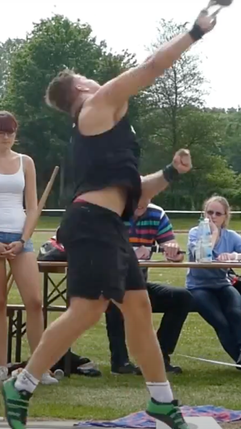

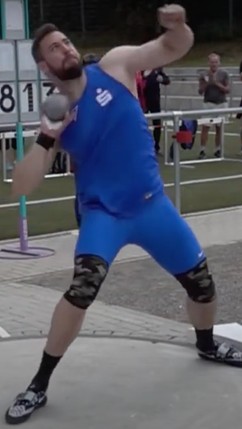

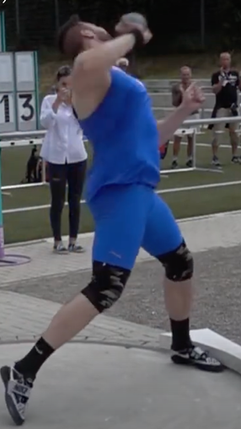













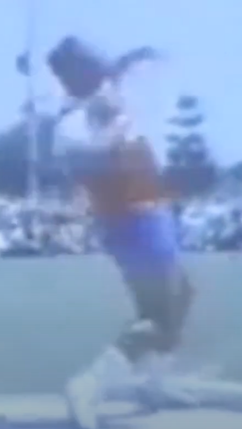





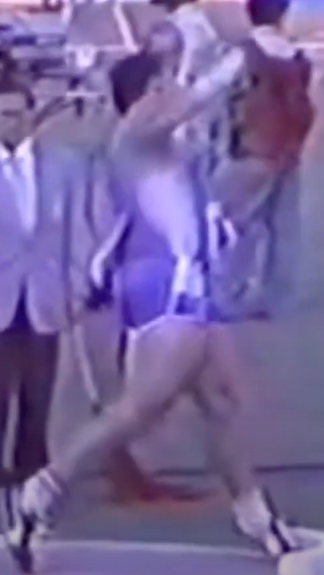







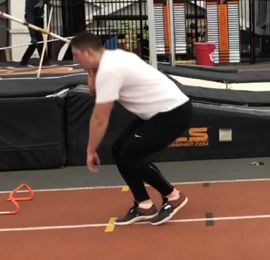
























Thank You for this excellent analysis.
Dane Miller at Throws University divides gliders into two overlapping classes - long/short and short/long depending on where the ball of the right foot lands relative to the center of the circles.
The right leg can either straighten as if the thrower was doing some sort of squat jump or rotate horizontally turning the knee to the front and pushing the right hip forward which has the effect of creating torque in the body as the left shoulder lags behind. In the case of the leg straightener, the right arm seems to strike at right angles to a fairly vertical torso. The desired 40 degrees or so trajectory is the vector sum of the…